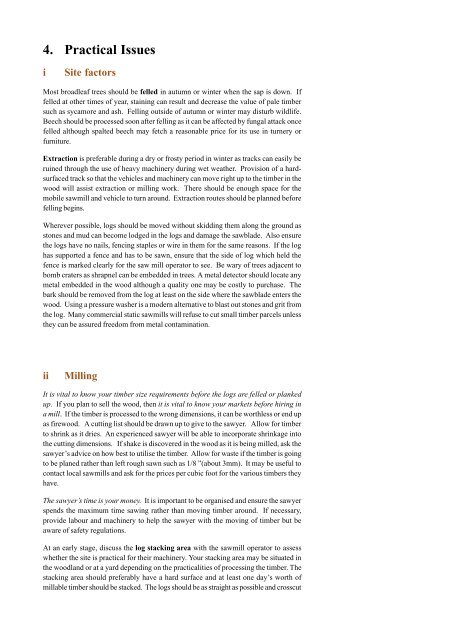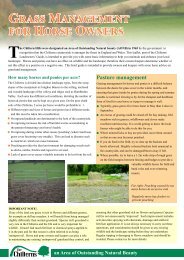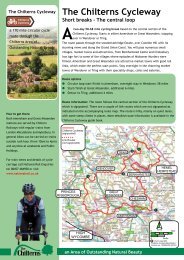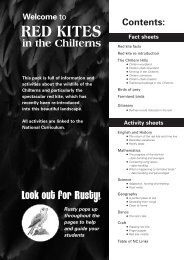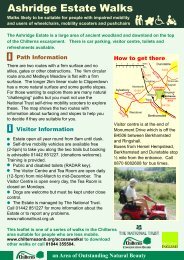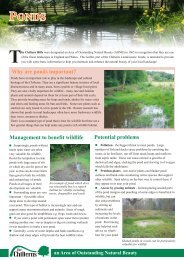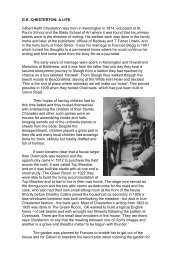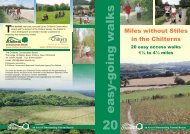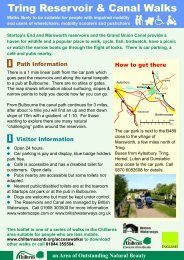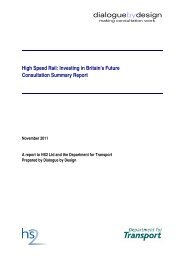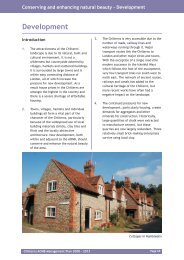on-site sawmilling and timber conversion information ... - The Chilterns
on-site sawmilling and timber conversion information ... - The Chilterns
on-site sawmilling and timber conversion information ... - The Chilterns
You also want an ePaper? Increase the reach of your titles
YUMPU automatically turns print PDFs into web optimized ePapers that Google loves.
4. Practical Issues<br />
i<br />
Site factors<br />
Most broadleaf trees should be felled in autumn or winter when the sap is down. If<br />
felled at other times of year, staining can result <strong>and</strong> decrease the value of pale <strong>timber</strong><br />
such as sycamore <strong>and</strong> ash. Felling outside of autumn or winter may disturb wildlife.<br />
Beech should be processed so<strong>on</strong> after felling as it can be affected by fungal attack <strong>on</strong>ce<br />
felled although spalted beech may fetch a reas<strong>on</strong>able price for its use in turnery or<br />
furniture.<br />
Extracti<strong>on</strong> is preferable during a dry or frosty period in winter as tracks can easily be<br />
ruined through the use of heavy machinery during wet weather. Provisi<strong>on</strong> of a hardsurfaced<br />
track so that the vehicles <strong>and</strong> machinery can move right up to the <strong>timber</strong> in the<br />
wood will assist extracti<strong>on</strong> or milling work. <strong>The</strong>re should be enough space for the<br />
mobile sawmill <strong>and</strong> vehicle to turn around. Extracti<strong>on</strong> routes should be planned before<br />
felling begins.<br />
Wherever possible, logs should be moved without skidding them al<strong>on</strong>g the ground as<br />
st<strong>on</strong>es <strong>and</strong> mud can become lodged in the logs <strong>and</strong> damage the sawblade. Also ensure<br />
the logs have no nails, fencing staples or wire in them for the same reas<strong>on</strong>s. If the log<br />
has supported a fence <strong>and</strong> has to be sawn, ensure that the side of log which held the<br />
fence is marked clearly for the saw mill operator to see. Be wary of trees adjacent to<br />
bomb craters as shrapnel can be embedded in trees. A metal detector should locate any<br />
metal embedded in the wood although a quality <strong>on</strong>e may be costly to purchase. <strong>The</strong><br />
bark should be removed from the log at least <strong>on</strong> the side where the sawblade enters the<br />
wood. Using a pressure washer is a modern alternative to blast out st<strong>on</strong>es <strong>and</strong> grit from<br />
the log. Many commercial static sawmills will refuse to cut small <strong>timber</strong> parcels unless<br />
they can be assured freedom from metal c<strong>on</strong>taminati<strong>on</strong>.<br />
ii<br />
Milling<br />
It is vital to know your <strong>timber</strong> size requirements before the logs are felled or planked<br />
up. If you plan to sell the wood, then it is vital to know your markets before hiring in<br />
a mill. If the <strong>timber</strong> is processed to the wr<strong>on</strong>g dimensi<strong>on</strong>s, it can be worthless or end up<br />
as firewood. A cutting list should be drawn up to give to the sawyer. Allow for <strong>timber</strong><br />
to shrink as it dries. An experienced sawyer will be able to incorporate shrinkage into<br />
the cutting dimensi<strong>on</strong>s. If shake is discovered in the wood as it is being milled, ask the<br />
sawyer’s advice <strong>on</strong> how best to utilise the <strong>timber</strong>. Allow for waste if the <strong>timber</strong> is going<br />
to be planed rather than left rough sawn such as 1/8 ”(about 3mm). It may be useful to<br />
c<strong>on</strong>tact local sawmills <strong>and</strong> ask for the prices per cubic foot for the various <strong>timber</strong>s they<br />
have.<br />
<strong>The</strong> sawyer’s time is your m<strong>on</strong>ey. It is important to be organised <strong>and</strong> ensure the sawyer<br />
spends the maximum time sawing rather than moving <strong>timber</strong> around. If necessary,<br />
provide labour <strong>and</strong> machinery to help the sawyer with the moving of <strong>timber</strong> but be<br />
aware of safety regulati<strong>on</strong>s.<br />
At an early stage, discuss the log stacking area with the sawmill operator to assess<br />
whether the <strong>site</strong> is practical for their machinery. Your stacking area may be situated in<br />
the woodl<strong>and</strong> or at a yard depending <strong>on</strong> the practicalities of processing the <strong>timber</strong>. <strong>The</strong><br />
stacking area should preferably have a hard surface <strong>and</strong> at least <strong>on</strong>e day’s worth of<br />
millable <strong>timber</strong> should be stacked. <strong>The</strong> logs should be as straight as possible <strong>and</strong> crosscut


